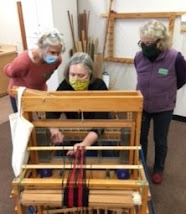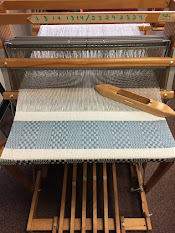 |
| October maple tree |
The fall foliage is lovely to look at but it comes with cooler temperatures and wetter days which is why we are glad to have access to our studio once more for indoor activities. The guild executive has developed a set of safety measures that comply with public health recommendations for Covid. That means we can hold small group events and make use of our equipment but our general meetings will be virtual. One positive side effect of the pandemic is that we are all learning to use technology such as Face Time and Zoom. Some of our grandchildren (or great grandchildren) are amazed!
Workshops are back! Class sizes are small to allow for social distancing and safety protocols are in place.
The ever popular Beginner Weaving classes are back with Sandra Schulz. This 3 part workshop starts on October 22. It covers the basics of weaving cloth on a harness loom. Each participant will be provided with a loom.
If you have mastered the beginnings of weaving and want to express your own ideas rather than follow a recipe then the following workshop is just what you need.
 |
Sandra Schulz deflected double weave scarf
|
How to Plan a Weaving Project with Sandra Schulz.
This one day session will help you avoid running out of yarn part way through a project or ending up with a blanket the size of a napkin. It will cover how to select the best yarn and weave structure for the project, what you can do with yarns in your stash and the when and how of mixing yarns. And finally Sandra will de-mystify yarn shrinkage, warp take up and sett. Students will design a weaving project from scratch, using a simple, easy to follow approach. Students will need writing materials and a calculator. The workshop takes place Saturday November 28 from 10am to 4:30. Cost, $90 for members and $115 for non-members.
 |
| Summer & Winter |
A Tale of Two Seasons with Linda Wilson
Our second weaving workshop for November will be something you can complete in the comfort of your own home. A Tale of Two Seasons is a virtual class using e-mail notes and presentations. It will cover the basics of the weave structure known as summer and winter. This is a versatile structure for producing colourful patterns. Both 4 shaft and 8 shaft versions will be covered. Linda is also planning some group Zoom sessions as part of this learning effort. Cost, $30 for members, $40 for non-members. The final date in November hasn't been selected yet. For more information on this course contact lraven49@shaw.ca
In our last post we saw two projects that were in progress. Wendy was busy dressing a table loom with a black warp of superwash merino wool. She turned it into a scarf with bands of blue twill accents at either end.
In the last post we also saw that Jan had just started a knitting project. Well Jan decided that the yarns and pattern weren't going to work and she wisely abandoned that project. But she has been busy using up yarns in her stash and has produced not one but 3 scarves. Two are hand spun wool and alpaca while the third is a mix of yarns.
In other news the spinning and knitting small group get togethers are happening in the studio on Tuesdays (spinning) and Fridays (knitting) from 10am to noon. Attendance is limited so members wishing to attend are to contact Terry. If you are not a member and would like to attend any of our sessions then contact us at qualicumweaversandspinners@gmail.com
The Fun with Four and Exploring More study groups are meeting via Zoom.
And finally the guild looms are also available for studio projects. Our 90 inch Leclerc is currently being used to weave warm wool blankets. One of the smaller looms is warped for cotton "golf" towels, a project that was halted in the early spring.


















































